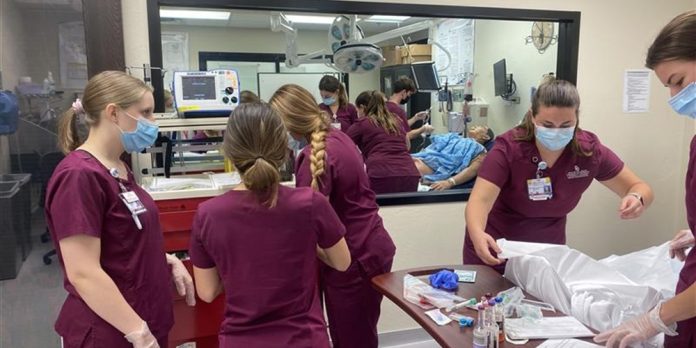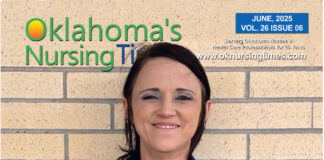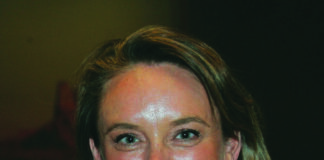Oklahoma Universities Confront Nursing Shortage | Dean Hoff Visits with The Journal Record
The nationwide nursing shortage continues, but the local outlook remains positive as universities ramp up efforts to reinforce numbers on the front lines. The University of Oklahoma and Marian University’s Oklahoma City campus have rolled out programming in the area to address a critical shortage of nursing care professionals. Oklahoma ranks 46th in the U.S. for nurses per capita, with just 7.5 nurses per 1,000 residents, according to the Bureau of Labor Statistics. (story continued below)
At Marian University’s Oklahoma City campus, Denise Ruth, faculty site director, saw its largest class of 17 admitted in the fall for its Accelerated Bachelor of Science in Nursing Program, a 16-month second-degree program that combines online coursework with hands-on learning and clinical rotations. The school has a partnership with Mercy Hospital to assist students with a career transition while providing qualified nursing professionals to Mercy’s system. “Our ultimate goal here at Marian is to continue supporting our community that needs the nursing staff to run the hospitals and clinics in the community,” Ruth said.
The Fran and Earl Ziegler College of Nursing at the University of Oklahoma began its partnership this fall with the University of Science & Arts of Oklahoma and Murray State College. According to a news release, the guaranteed admission opportunity establishes OU as the preferred collaborator to advance nursing education in Ardmore. As many begin their careers close to where they receive their degree, it’s believed that the program will result in more nurses in rural areas where the need is most pronounced. It’s the second initiative in recent years to address the shortage. Last year, the college expanded the size of its nursing class capacity for both its traditional BSN program and the accelerated BSN program.
The school enrolled 296 freshman students in the fall semester of 2020. This fall, the school welcomed 517 new students to the school, according to data from the OU College of Nursing. Julie Hoff, dean of the OU College of Nursing, said the school is graduating more nurses than ever, but the issue is hospitals continue to need nurses, and many graduates end up working in insurance, pharmaceuticals and outpatient care. She said it’s important to clarify that the nation is experiencing a “nursing care shortage.” “Even though they might be choosing to work in hospitals, they’re not staying in hospitals” Hoff said. “The percentage of nurses working in hospitals right now is at an all-time low.” Hoff said in 2011, close to 62% of nurses worked in hospitals, but that has declined to nearly 57% in 2023. Nursing professionals have become increasingly outspoken about the conditions of working at hospitals since the COVID-19 pandemic. The American Nurses Association reports burnout, high patient-to-staff ratios and early retirement as reasons for the shortage, only heightened by the surge of Americans seeking care during the pandemic. Additionally, the association reports that 1 in 4 nurses report being assaulted on the job. “We have to recognize that nursing truly is the oxygen of the health care system,” Hoff said. “Yes, it takes a team to take care of patients and families, but nurses provide a majority of the direct care in the U.S., and they’re very critical to our fragile health care system.”
Mercy Health makes monthly contributions toward any current outstanding student loan debt for nurses who qualify. Pell Grant recipients can receive up to $20,000 in repayment assistance. Emily Erikkson, executive director of nursing at Mercy, said its program is key during a time when hospitals everywhere are struggling coming out of the pandemic to retain and recruit nurses into the hospital setting, which can be stressful at times.
Erikkson said nursing care is a job that’s needed 24 hours a day, and night shifts and weekends can be reasons why some students look outside of a hospital setting for employment. “But we also do have some who have the drive to work in a hospital setting, and those are the ones we’re trying to get out there and capture,” Erikkson said. Nurse Journal reports the shortage is projected to peak in 2027 and ease over subsequent years. Despite the long-term uphill battle, which is expected to continue, Erikkson said her outlook is optimistic. “We have gotten across the line in the post-pandemic world, and I feel like we’re on the right path now to building up that workforce,” Erikkson said. “We’re getting very creative with how we do staffing and things like that in the hospital setting to help provide some of that work-life balance for our nurses, so they can have that time at home and here in the hospital if that’s where they choose to work. But we’re on the right track moving forward.”













